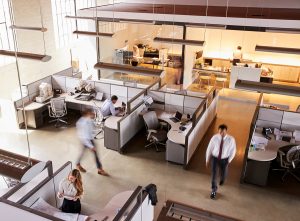Did you know? Around half of all Australians work jobs where they spend most of their time sitting.
Unfortunately, this sedentary lifestyle isn’t helping with those who suffer severe back pain.
The problem arises when people don’t take active measures to balance out their largely desk-bound jobs.
Think about all the hours you spend sitting (or lying down) in a day:
- 8 hours sleeping
- 30 mins commute to work in the car
- 8 hours, desk-bound
- Another 30 minutes driving home
Once you arrive home, it’s likely you’ll prepare dinner than settle down again on the couch for some TV time.
And thus, an increasingly sedentary population is leading to significant negative health outcomes – one of which could be a dramatically higher chance of back pain.
Who’s at the biggest risk of back pain?
People with sedentary jobs
Do you:
- Work in an office from 9 to 5?
- Drive a taxi or any other transport or courier vehicle?
- Operate machinery which forces you to sit most of the day?
If so, you aren’t immune from back pain – in fact, you face a surprisingly high risk of back pain. As such, you’ll want to be more physically active!
There are a couple of ways sitting for extended periods can lead to back pain.
Sitting is a very high position of compression for the discs in the lumbar spine. Like we’ve mentioned before, your spine is designed to stand up straight.
This is the most ideal way to evenly distribute and support your bodyweight.
The problem is that sitting ingrains bad posture. Some people slouch since it’s more comfortable, while others lean all the way back in their chairs.
These habits reinforce bad posture, which in turn leads to:
- Weaker back muscles
- Less support for your body
- Suboptimal weight distribution
Each puts strain on your spine and the muscles in your back, leading to back pain.
Another way that sitting causes back pain is by weakening your muscles. Use it or lose it – that’s the basic principle that underlies pretty much all physiotherapy.
And unless you’re making active use of your muscles, they weaken and atrophy. They become less able to deal with all the pressure and strain that your body undergoes on the daily.
The result? Back pain!
People who work physically intensive jobs
It’s not just inactivity that puts you at risk of back pain – it’s possible to have too much of a good thing.
Professions that require a lot of physical activity are even more likely to suffer from back pain.
For example, tradespeople and physical labourers are some of the most common clients we provide physiotherapy for.
This should come as no surprise. After all, people who are employed in these lines of work:
- Constantly stoop and bend over
- Lift heavy loads
- Spend extended periods of time on their feet
- Perform repetitive movements
- Often overexert themselves
Over the years, this degrades and damages your back muscles. And damaged back muscles mean one thing…
Luckily, there are a couple of things you can do to minimise your risk of back pain and relieve felt pain.
1) Lower back pain release
While it may sound complex, in truth this exercise is dead easy. All you need are three things: a floor, something to rest your feet on and a ball.
What you want to do is:
- Lie down on the ground and place your feet on the footrest
- Place the ball underneath your back where you feel back pain
- Roll your body over the ball. Perform a left-right swinging motion like you’re relaxing in a hammock
- Repeat for as long as needed (at least 2-5 minutes)
This technique relieves pain by peeling muscles away from each other. In essence, it’s a bit like a DIY deep massage for your back – it’s all about releasing muscle and neural tension and getting your brain to send pain-blocking messages to the area that’s sore.
Want to learn more? Watch the video below.
2) Using tools and supports is not cheating
As we mentioned above, bad posture has a big role to play in putting unnecessary strain on your back and causing back pain.
As such, when it comes to posture and back pain, ergonomic supports are your best friends.
In addition to correcting bad posture, supports such as braces, tape and ergonomic seat cushions also help redistribute weight, taking the pressure off your back.
While it may seem awkward or uncomfortable initially, long-term this resolves any back pain that arises from postural problems, and shields you from future back pain.
3) Keep active throughout the day
Do you work from a desk? If so, preventing back pain can be as simple as performing minor exercises throughout the day.
Staying active doesn’t have to mean spending your lunch break by going out on a jog. In fact, staying active can be as simple as:
- Getting up and taking a stroll around the office every 20 minutes
- Parking further away from the office
- Standing up instead of taking a seat on the train
Each of these activities keeps your back muscles active, protecting you against future back pain.
Do some gentle bending and straightening throughout your day.
The constant balancing act and readjusting keeps your back muscles active throughout the entire day. This strengthens your muscles, insulating you against future back pain.
4) Regular breaks, stretches and exercises
Say you’ve got the opposite problem. Instead of spending
Heavy lifting and repetitive movements – two staples of physical work – can take a toll on your back. Taking periodic breaks and gently stretching out your muscles every now and again eases tension in your muscles and relieves back pain.
The below video talks you through some exercises you can do from home. Just a heads-up, the video’s a tad long – you might want to put on the kettle and get comfortable (or don’t, if you suffer from postural issues!)
5) Change how you work
In some jobs, muscle overuse is unavoidable: a bricklayer, for instance, can’t ease off on the lifting – it’s just part of the job.
What you can do however is modify the repetitive tasks you need to perform.
Do whatever you can to reduce overuse and strain.
For example, if your job involves a lot of lifting, consider using lifting devices if possible. Alternatively, you could alternate physically-demanding tasks with less intense ones, giving your back a brief rest.
Sometimes, changing your habits comes down to changing your technique. For example, your back pain mightn’t be because you’re lifting heavy loads – it could be because you’re doing it wrong!
In these cases, a Highett physio can help you correct improper technique. If you lift with your back, we train you until lifting with your legs becomes your default.
Get in touch with your Highett physiotherapist
Need physio for back pain? Physio AUS has you covered!
Drop by our Highett physio clinic – our talented team provide remedial treatments that relieve your pain and help you return to pain-free.
In addition to remedial treatments, we also offer physiotherapy for back pain. We don’t just relieve pain – we ensure that it never makes a return.
Book a session at our Highett physio clinic.
Have questions? Explore our blog or feel free to ask us here.

 1300 392 552
1300 392 552

Leave A Comment